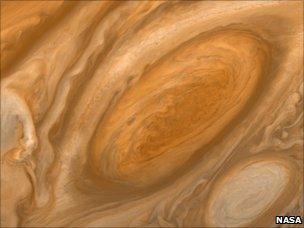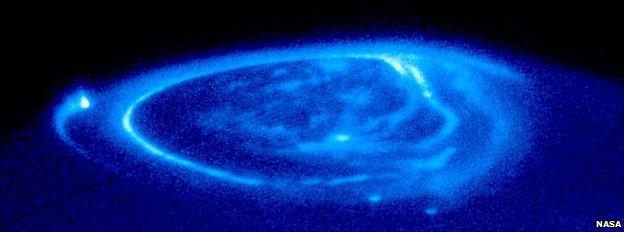Juno probe goes 'back to Jupiter'
- Published

Distant solar power: Juno's orbit around Jupiter has been designed so that it never goes into shadow
Nasa's $1.1bn (£0.7bn) Juno mission will venture where no solar-powered spacecraft has dared go before.
The probe, due to launch from Cape Canaveral on Friday, will cruise beyond Mars to put itself in orbit around the gas giant Jupiter in 2016.
At this distance, where the intensity of sunlight is only 1/25th of that at Earth, one would normally resort to a plutonium battery.
But Juno will instead travel with three wings coated with 18,000 solar cells.
At Earth, these 9m-long arrays will produce over 14,000 watts - enough to power an electric car. At Jupiter, they will muster a little over 400 watts - enough for just a few incandescent lightbulbs.
Of course, it is not lightbulbs Juno's panels must support, but scientific instruments.
Nonetheless, Scott Bolton, the mission's chief scientist, believes his spacecraft will cope just fine in the dim outer reaches of the Solar System.
"As a solar-panelled mission, we have to keep those solar panels facing the Sun and we never go into Jupiter's shadow," he told BBC News.
"Those are things we can do and still accomplish our science; it doesn't hurt us. But it would have been easier if we could have pointed just any way we wanted. We've had to develop [a strategy], and in fact we've advanced solar cell technology in doing so."
When Bolton and colleagues submitted their proposal for a Jupiter mission, a plutonium thermoelectric generator simply was not available. There were development ideas within Nasa, but the Juno team thought it less risky to go with solar cells than wait for a nuclear option to present itself.

Juno's mission is to explain the Solar System by explaining the origin and evolution of its biggest planetary member.
The spacecraft's remote sensing instruments will look down into the giant through the many layers and measure their composition, temperature, motion and other properties.
This should yield some remarkable new insights into the coloured bands that wrap around the planet, and a new perspective on the famous Great Red Spot - the colossal storm that has raged on Jupiter for hundreds of years. Juno will tell us how deep its roots go.
A key quest is to measure the abundance of water in the atmosphere - an indicator of how much oxygen was present in Jupiter's region of the Solar System when it formed, and perhaps a tell-tale of any migration from its original formation location.

Jupiter's Great Red Spot: A persistent storm located just south of the planet's equator
The probe will also try to settle old arguments over whether the planet hosts a rocky core or whether its gases go all the way down to the centre in an ever more compressed state, under perhaps 40 megabars of pressure (40 million times the air pressure experienced at sea-level on Earth).
And it will look for the deep swirling sea of liquid metallic hydrogen that many suspect is the driver behind Jupiter's strong magnetic field.
All this information bears down strongly on the competing theories for how the eight worlds we now call planets came into being.
"Jupiter probably formed first; it's the largest of all the planets. In fact, it's got more material in it than all the rest of the Solar System combined," explained Dr Bolton, who is affiliated with the Southwest Research Institute (SWRI) in San Antonio, Texas.
"So, after the Sun formed, it got the majority of the leftovers. And that's why it's very interesting to us if we want to go back in time and understand where we came from. Jupiter holds the secrets. We want to know the ingredient list - what we're really after is discovering the recipe for making planets."

Critical electronics in Juno have been placed inside a 1cm-thick titanium box
Jupiter's immense magnetic field accelerates particles to tremendous speeds, rendering the local environment the number one hazardous location in the Solar System for electronics (apart from the Sun's immediate vicinity).
To prevent these critical systems being scrambled, Juno carries them inside a titanium vault.
The rocket chosen by Nasa to launch Juno is the Atlas V, the vehicle recently identified by the space agency as a possible future astronaut launcher.
Lift-off from the Cape Canaveral Air Force Station on Friday is timed for a window that opens at 11:34 local time (15:34 GMT; 16:34 BST).
Juno will head out into space but it will come back to Earth briefly as it looks to pick up the speed it needs to shoot itself out to Jupiter.
Jan Chodas, the Juno project manager, explained: "We launch from Earth; we swing out past the orbit of Mars; we fire the engine to do a couple of deep-space manoeuvres, to target us to come back in by the Earth. And we do a flyby of the Earth at about 500km in October of 2013, and then we slingshot ourselves out towards Jupiter, arriving in July 2016."
Juno is the second in Nasa's so called New Frontiers class missions. The first, New Horizons, was launched towards dwarf planet Pluto in 2006 and should arrive at its target in 2015.
"Juno was confirmed on August 5, 2008, and here we are ready to launch Juno on August 5, 2011 - three years later," said Jim Green, the director of planetary science at Nasa. "Juno is on schedule and on budget."

Jupiter has the strongest magnetic field of all the planets and the most energetic auroras as a result
- Published18 July 2011
- Published9 June 2011